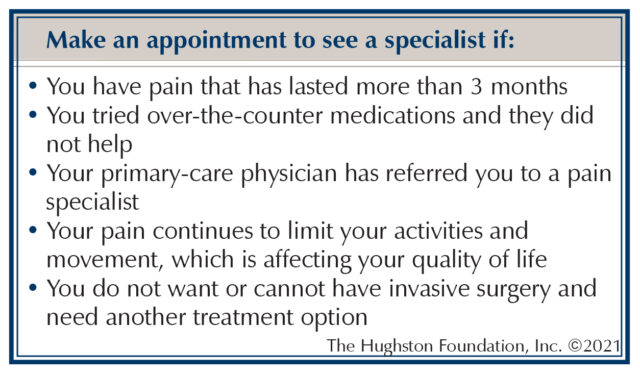
You may feel as if you are on an endless journey to find pain relief. If you feel that way, you are not alone. Most patients go to an interventional pain management physician after they have exhausted many other treatments. If you suffer from chronic pain, interventional pain management may be the solution you have been searching for.
What is interventional pain management?
When pain has become so extreme that it makes everyday a struggle, it is time to see a physician who can help. With interventional pain management, your physician uses minimally invasive procedures to interrupt the nervous system’s transmission of pain by blocking the messages sent from nerve endings to the brain. Depending on your specific condition and symptoms, your doctor will discuss the procedures available to you. The goal of the treatment is to disrupt the pain cycle and reduce or completely alleviate your pain.
What is the difference between pain management and interventional pain management?
Pain management consists of noninvasive methods such as prescribing medications, whereas interventional pain management includes minimally invasive treatments. For example, your primary care physician may prescribe an over-the-counter medication to help ease your pain for a short duration of time, while your interventional pain management physician will often perform a procedure that can block the pain or permanently correct the problem that is causing your pain.
Why not take medication?
Taking a pain pill may appear to be a quick and easy solution; however, pain medications can have adverse side effects. Your physician may prescribe acetaminophen to treat mild to moderate pain or a stronger medication, such as an opioid, for acute pain. If your doctor prescribes these medications, he or she will instruct you to take them for a limited time so you are less likely to experience a side effect, like becoming addicted to an opioid. Besides dependence, opioids and other pain medications can cause a number of side effects such as, constipation, nausea, vomiting, dry mouth, sleepiness, dizziness, confusion, depression, itching, and sweating. Taking medication is helpful for some types of pain, but for relief of chronic pain, you may need another specialized treatment.
What are the benefits of interventional pain management?
The procedures are minimally invasive, usually take under an hour, and generally do not involve any kind of incision or scar. Additionally, for the vast majority of procedures, there isn’t any hardware such as plates or screws inserted into your body. Your doctor can also treat multiple joints at one time, such as injecting both knees or target multiple joints of the spine that may be causing pain. It is also ideal for patients who cannot undergo a major surgery due to other health conditions or for those who simply do not want surgery.
Seeing an interventional pain management physician
During the doctor’s visit, the physician will take your medical history and perform a physical exam, which helps evaluate the nature of your pain. Your physician may order x-rays or magnetic resonance imaging (MRI, a scan that shows the bones, muscles, tendons, and ligaments). Not all patients will require an MRI, but based on the severity of your pain and the results of your physical exam, the scan can help determine the extent of damaged structures. During the visit, your doctor will likely ask questions to help determine the course of treatment. For example, is this the first time you have had pain or have you had other problems before.
Am I a good candidate for interventional pain management?
Interventional pain management can provide relief if you suffer from an injury or ailment that limits your normal daily functions or physical activity, especially if you have a soft tissue injury such as a partial tear in your tendon, ligament, or a muscle. If you had other treatments such as physical therapy, nonsteroidal anti-inflammatory medications (NSAIDS), or steroid injections that did not provide significant or long-lasting relief, another type of interventional pain treatment may be a viable solution. You may want to try interventional pain management if you would like to explore a minimally invasive alternative rather than having a major surgery, such as spine surgery.
Many patients suffering from back or neck pain are not ready for invasive surgery like a spine fusion. They are also looking for a longer lasting alternative to medications and one that has fewer side effects. Patients can become frustrated with the duration of relief of other nonsurgical options, such as physical therapy. You should visit a pain management specialist if your attempts at finding relief have failed.

Is interventional pain management safe?
The risk of side effects exists for most medical treatments and interventional pain management is no different. Rare, but possible, complications caused during a procedure can include an allergic reaction to the local anesthetic, damage to the underlying structures, infection, and hematoma (collection of blood) or seroma (an accumulation of blood or fluid under the skin that may require removal). Although each of these outcomes are possible, they are exceedingly uncommon, and the overwhelming majority of patients do very well after they undergo an interventional procedure.
Common types of treatment
Interventional pain management provides patients with minimally invasive options to treat pain without the use of drugs or major surgery. These patients often suffer from pain caused by arthritis, bursitis, degenerative disc disease, herniated discs, injuries, osteoporosis, rheumatoid arthritis, sciatica, and tendonitis. Depending on your condition, your doctor will determine which procedure is best for you. Nerve blocks, injections, ablations, spinal cord stimulations, and orthobiologics are just a few of the techniques interventional pain management includes.
Nerve blocks: Since pain travels through nerves to the brain, physicians use nerve blocks to interrupt the signals. The type of nerve block your doctor uses will depend on your diagnosis and health history. After a nerve block, your pain relief may last for weeks, months, or in many cases, years. Depending on your problem and the type of procedure you undergo, many patients will experience permanent pain relief in the area that was treated.
Injections: Usually include a numbing agent and steroid that targets different areas of pain in the body. Some patients prefer injections, such as facet joint injections (Fig. 1), epidural steroid injections (Fig. 2) and trigger joint injections because they are easily administered, minimally invasive, and provide effective pain relief.
Radiofrequency ablation: Uses a radio wave to produce an electrical current that physicians use to heat an area of nerve tissue. The nerves that are targeted are only used for sensation, and are not required for any kind of movement of your body and are therefore safe for treatment. This procedure decreases the pain signals in the area of treatment and is most often used for treating low back or neck pain. There are many other types of nerve ablations for other areas of the body. This can make it useful in particular for those patients who wish to avoid surgery.
Spinal cord stimulation: Treats chronic pain by applying gentle electrical currents to the source of your pain. Your physician will apply electrical leads close to the spinal column, while also inserting a tiny generator into the abdomen or buttock. The generator emits electrical signals to the spinal column, thus blocking the brain’s ability to perceive pain. For many patients who have suffered with chronic pain for years and have failed things such as back or neck surgery, this can be a life-changing treatment.
Orthobiologics: The goal is to aid the body’s response by using orthobiologic products, which are substances naturally found in the body. In particular, research attention has been on using adipose (fat) tissue (Fig. 3), scaffolds, stem cells, platelet-rich plasma (PRP) (Fig. 4) and growth factors in orthopaedic surgery and nonsurgical treatments. These procedures are minimally invasive and while no treatment can fully heal damaged joints, these approaches are showing promise in an array of conditions.
Start a pain free journey
Your journey to find pain relief may have been a long one. Being inundated with pain impacts every part of your life. It leaves you tired, irritable, distracted, and of course, hurting. See an interventional pain management physician for a complete and thorough evaluation to start a new journey of living pain free.
Author: Forrest P. Allen, DO | Nashville, Tennessee
Last edited on September 24, 2024
